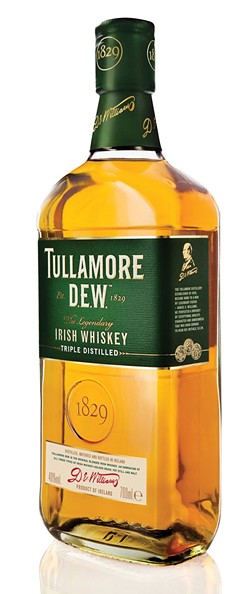
When an Irishman who has embarked on a 30-day mission to drink at pubs in all 50 United States popped into town recently, how could I say no to the opportunity to sip whiskey with him? He'd just been to Hawaii and Alaska, and came through Salt Lake City on his way to Albuquerque, N.M. It was an invitation I couldn't resist.
Tim Herlihy looks barely old enough to drink, dressed casually in Converse low-tops and rolling his carry-on suitcase into Piper Down. He's the New York City-based brand ambassador for Tullamore D.E.W., which means a lot of his time is spent traveling the country and educating all interested parties about Irish whiskey in general, and of Tullamore D.E.W., in particular. It's a tough job, but somebody has to do it. Herlihy is very good at his job. In 2015, Whisky Magazine named him one of its Icons of Whisky as Best Irish Whiskey Ambassador.
Not a big whiskey drinker myself, I asked Herlihy for a primer in Irish whiskey versus Scotch. Both are made from grain, but that's about as much as I knew. For starters (and most obviously), Irish whiskey must be distilled and aged solely in Ireland, just as Scotch whiskey must be made in Scotland. Most Irish whiskey is triple-distilled (which is the case with Tullamore D.E.W.), while most Scotch whiskey is distilled twice. But probably the biggest difference in Scotch versus Irish is the use of peat in Scotland, which lends smoky notes to most Scotch whiskeys. Irish whiskeys tend to have a smoother finish.
One thing that separates Tullamore D.E.W. from other Irish whiskeys is that it's a blend of three types of Irish whiskey: grain, malted barley and pot-still whiskey. This blend results in a whiskey that is smooth—even buttery—but also complex.
As I take my first sip of Tullamore D.E.W. Original ($28), Herlihy explains the name of the company for which he works. "Tullamore D.E.W. gets its name from both the town of Tullamore located right in the center, right in the heart of Ireland," he says, "while the D.E.W. in Tullamore D.E.W. is named after Daniel E. Williams, a man who went to work at the old Tullamore Distillery at the age of 14. Daniel then climbed his way up the corporate ladder of the distillery and eventually went on to own it. When he bought the Tullamore Distillery he lent his initials to every bottle, which spelt D.E.W."
Anyone who hails from Termonfeckin, Ireland, has to have a hearty sense of humor, and, as a Termonfeckinite, Tim Herlihy does. He's outgoing and very funny but still somewhat low-key. You wouldn't think to call him a "salesman"; he was almost as keen on talking about Utah's whiskeys as he was his own.
Tullamore D.E.W. 12-Year-Old Special Reserve ($42) is unique. Its texture is creamy, and there are distinct chocolate notes. But it's also loaded with spice; the tip of my tongue burned like I'd been chewing on jalapeños, and I loved it. As I enjoyed my Special Reserve, I mentioned that I was planning to visit Paris soon. To my surprise, Herlihy told me that the bar with the world's largest Irish whiskey selection—over 330 of them—is in Paris. Naturally, it's called Patrick's.
Tim Herlihy will wind up his U.S. pub crawl on St. Patrick's Day in New York City at his favorite Manhattan bar, The Dead Rabbit. On the way to drop him off at the airport, I ask Herlihy if he doesn't ever get tired of drinking whiskey. "Not really," he responds, "I'm Irish." And with that, he rolls his luggage from the curb, destined to find the High West Distillery outpost at Salt Lake City International Airport.